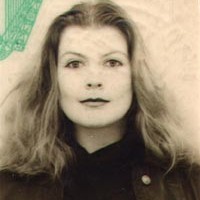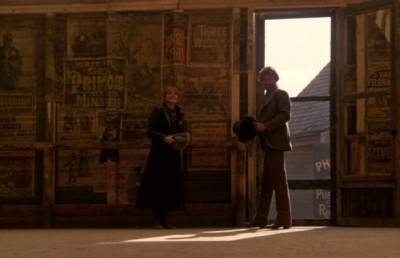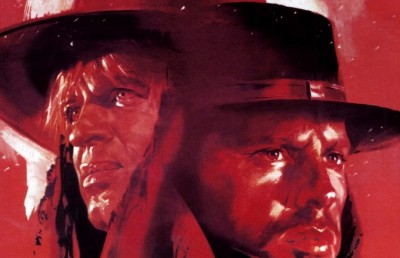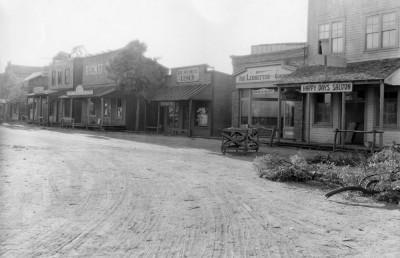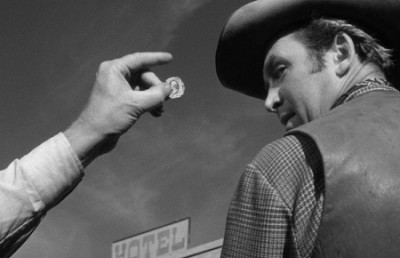The Final Showdown: 7 Men From Now (1956)
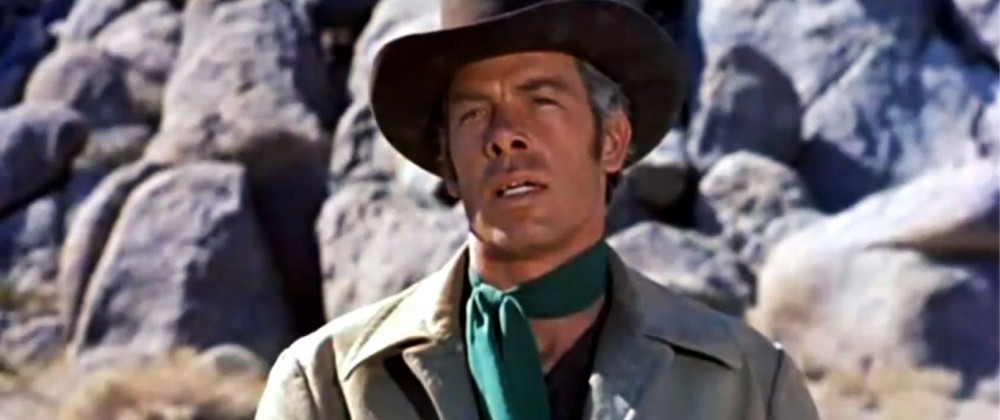
Directed by Budd Boetticher from a story and screenplay by Burt Kennedy, 7 Men From Now remains a minor masterpiece of the Western genre. Crucial to its success is the unified screenplay by Kennedy which rigorously ties plot elements to dramatic development in masterful fashion. When it was released, the western genre was enjoying a revival both in terms of its form and critical reception. Since 1950, when the release of Winchester ‘73 (Anthony Mann) and The Gunfighter (Henry King) marked a kind of rebirth or development, it had been reinventing itself in ways that could be described as a transition to a mature form.
Critic Richard Schickel claims that,
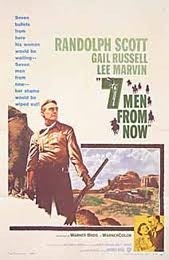
When we go to the movies we instinctively understand that ‘narrative and construction’ – the plot, to use the simplest possible term – is the voice of authority to which we are supposed to respond. In the vast majority of movies it dictates the development of the characters and it is what carries the moral. And it is, of course, the plot that is crucial to the development of the film from first to last; it is the subject of the treatment that is the first cause of the studio’s commitment to a project; it then becomes the matter that everyone connected with a movie argues about from first-draft screenplay through final cut; it is what the marketing department adapts as the basis of its ad campaign; it is what viewers tell their friends about; and, yes, it is what reviewers mostly review. For it is the aspect of a movie that is most readily reducible to a few well-chosen judgmental words.
(Schickel in Lopate, 1995: 559)
The plot, in terms of Kennedy’s expression of it, devolves on the principal elements of the Western’s action – the hero, the villain and the motive. The heroine is the secondary motor for the action yet remains out of sight though embodied in a new version in this instance. Former Sheriff of Silver Springs Stride (Randolph Scott) takes revenge on the men who killed his wife in a Wells Fargo robbery and is trailed by other men who want to find the $20,000 in the missing strongbox. After killing the first two men, he encounters the Greers, a couple intent on finding their way West to California through Chiricahua country, but seemingly incapable of doing so without accident or incident. Stride agrees to help them find their way South, around the Apache troublespots. En route they meet Masters (Lee Marvin) a villainous acquaintance of Stride’s whom Stride had imprisoned – twice. He is accompanied by his sidekick, Clete (Donald Barry.) David Bordwell identifies basic story structure as “… an undisturbed stage, the disturbance, the struggle, and the elimination of the disturbance” (Bordwell, 1985: 157). The men of the title constitute the disturbance in the status quo and represent the means to an end – the action that Stride must take to avenge the brutal murder of his wife as she did her job clerking at a depot in Silver Springs – a job she had to take because he lost his bid to be re-elected Sheriff the previous Fall. The film commences on a crash of thunder. It boasts a title song whose lyrics tell us, ‘When they hear the mighty voice of justice one by one, seven men will die.’ We enter the story as Stride enters a cave which is the hideout of two nervous men on a dark and stormy night and responds to their enquiry about the whereabouts of his horse after an encounter with Chiricahua Apaches, with the line, “They ate him.” He then swiftly kills the first two of his quarry. The stage is set. The next scene takes place in parched daylight, a lush landscape refreshed by the night’s downpours, and Annie Greer (Gail Russell) falls into a waterhole from a wagon stuck in the mud.
As Lee Russell comments, “the central problem in Boetticher’s films is the problem of the individual in an age – increasingly collectivised – in which individualism is no longer at all self-evident, in which individual action is increasingly problematic and the individual no longer conceived as a value per se” (Russell in Kitses and Rickman, 1998: 197). This presents certain fundamental dramatic problems. Russell finds these problems at work in Boetticher’s films yet they are more complex than early westerns despite Scott’s bearing something of a resemblance to William Hart (as noted by Bazin). The principal issue is solved by breaking down groups of people into their constituent individuals and then by dramatising their external and inner conflicts. Stride separates and then picks off the villains led by Payte Bodeen (John Larch); this action is repeated to a degree in the later Buchanan Rides Alone (1958).
If a screenplay or theatrical drama is “ordered structure,” then this structure is composed of connected events which are self-contained (Heath in Aristotle, 1996: xxiii). The cause and effect linear story is one that has pertained in Hollywood screenwriting since the first proper template was established in 1917 or thereabouts. For Aristotle, action is “… the source and (as it were) the soul of tragedy; character is second” (Aristotle, 1996: 12). The protagonist’s desire is the story’s driving force. The ordering (or reordering) of story elements amounts to a narrative syntax around certain points which Ricoeur refers to as ‘emplotment.’ Referring to the interaction between story, event and emplotment, Paul Ricoeur writes that
… an event must be more than just a singular occurrence. It gets its definition from its contribution to the development of the plot. A story, too, must be more than just an enumeration of events in serial order; it must organise them into an intelligible whole, of a sort such that we can always ask what is the ‘thought’ of this story. In short, emplotment is the operation that draws a configuration out of a simple succession.
(Ricoeur, 1990: 65)
In 7 Men …, the emplotment is structured around a single action, or an action linked in different locales and moments, by the motive of revenge. Emplotment is not limited to events, it is also a process through which a kind of identity is constructed. In this case, Stride’s identity is for the most part limited to this single motive and expressed through a series of violent acts.
There is . . . not just an emplotment of actions; there is also an emplotment of characters. And an emplotted character is someone seeking his or her or its identity. (Ricoeur and Pellauer, 1995: 309)
We might then suggest that the term ‘structure’ be applied to the narrative configuration of emplotment; and that the rhetoric of structure could be denoted as described: action (story or plot); character; dialogue; genre; location; theme; tone (point of view) and visuals. This, then, is the foundation of the identity of the screenplay. Lajos Egri advises, “If we wish to know the structure of conflict, we must first know character. But since character is influenced by environment, we must know that too. It might seem that conflict springs spontaneously from one single cause” (Egri, 1960: 136). In other words it is the gap – or lack – between what the character wants and what the character needs that creates narrative motion. Whereas Aristotle’s analysis of drama focuses exclusively on plot and action, it is true to say that what grips an audience is character. Burt Kennedy’s approach to screen stories is embedded in a fundamental (even instinctual) expression of this idea and in 7 Men From Now the entire screenplay is embodied in the one word that is never verbalised and, that is, revenge. Stride’s entire character devolves upon that word. His action is confined to its expression and his life is dependent on this quest.
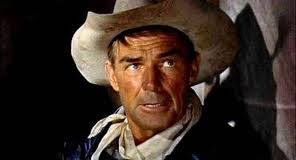
Randolph Scott, laconic hero
According to Bordwell, linear development in classical Hollywood structure is complicated by plot being split into two lines of action, the one dominated by heterosexual romance; the other to do with work or an occupation that takes place in the public sphere. (Ibid.) Genre deploys oppositional elements (contrasts) in the narrative, which encourages analysis of a structuralist nature (Cohan, in Gledhill and Williams, 2000: 56-58). In _7 Men_… the heterosexual romance line is rendered complex by its trigger – a death. It is made doubly complicated by the new romance in the story, which is that involving a woman already married to a man possibly implicated in the death of our hero’s wife. Not only this, but the woman’s resemblance to Stride’s dead wife introduces the possibility that Stride’s motive could be complicated by a love interest that seems eerie and unbalanced. These almost phantasmagorical aspects lend tone and texture to what might be described as a chamber-Western. As Russell reminds us, Boetticher stated of his women characters, and despite the impact Annie has here on Stride (and the other men), “ ‘What counts is what the heroine provokes, or rather what she represents. She is the one, or rather the love or fear she inspires in the hero, or else the concern he feels for her, who makes him act the way he does. In herself the woman has not the slightest importance’” (Russell: 200-1). She begins in an undignified fashion, splashing about in the mud; she washes in the rushes at the waterhole; she serves coffee in a dignified fashion; she gradually figures desire and replenishment until that point where she is associated with the saloon whores and her attractiveness is made explicit. Ultimately, she offers a safe place. Stride can talk to her of things intimate and deeply personal, filled with regret about the pride that made him turn down the job of sheriff’s deputy, forcing his wife into the workplace and thence the events leading to her murder. However, frontier life changes from moment to moment – with gunfire – and as the journey continues, the action both narrows and expands: Stride approaches his goal and realises something about his travelling companions and their business in Silver Springs; while his own personal journey results in his admission that he believes himself to blame for his wife’s death. As Stefan Handzo points out, the inner-directed Western hero had now – in the Boetticher/Scott cycle at least – become an “archaic, ruthless monomaniac” (Handzo, 1976).
James Monaco states that, “movie genres are simply formulaic patterns, some stricter than others” (Monaco, 1979: 54). Barry Langford explains that genre films can be “understood as the systematic, routinised production of genre films for a regular mass-audience spectatorship” (Langford, 2005: 274; 261). Far from being devalued, genre filmmaking is more important to the film industry than ever before. Langford states that the area of genre study has become intensely complicated in recent years following a period of consensus throughout the 1970s and 1980s. Ideological formation and cultural hegemony underlie all these writings as a given, while the transgeneric blockbuster and industrial realignments of recent years have combined to prove an overwhelming challenge for analysts. As the author reminds us, “Hollywood films today are as intensely generic as ever, perhaps even more so.” He explains that, “film genre theory … acknowledges that representational and narrative conventions supply important frameworks for meaning construction” (Ibid.).
Stuart Kaminsky claims that “genre helps us see the unique properties of individual works by permitting comparison of these works with others of the same basic type. He continues that “the roots of genre are not solely in the literary tradition, but in the fabric of existence itself” (Kaminsky, 1977: 12; 14). The western genre was evolving at the time this film was produced, and it has many of those elements which point to the modernising of the form as well as openly embracing new facets that were current in the 1950s, particularly the fore-fronting of the woman’s role. While neither Boetticher (nor Kennedy, at least at this time) had much interest in doing this, it is Gail Russell’s performance as Annie Greer that grounds this film in emotion. She starts as an object of fun – taking a spill in the mud when we are first introduced to her, implying a fertility denied Stride in his deceased wife; but she becomes a signifier of possibility and hope. She is a virtual replica of Stride’s dead wife, as we learn from Masters, although he claims she is better looking! She is linked with Stride visually through the simple expedient of having him sleep beneath her on the outside of the covered wagon, across the wheels’ axles. She then becomes overtly associated with sex through a simple signifier – a red kerchief tied around her hair as she hangs washing out on a line – and later the colour is repeated in a painting on the wall of the saloon at Flora Vista, an idea given vivid expression when the in-house whores descend the staircase and the colour’s function is evident. This brings to play another element that would become important in the Ranown cycle: the idea of doubling and parallelism. Stride is able to open up to his innermost feelings to her, approximately two-thirds of the way through the narrative when the wagon is sheltered under trees from the heat of the noonday sun and at one point lifts her tenderly down from the covered wagon and they are almost in a clinch. “They’ll kill you, won’t they,” she says. “They’ll try,” he responds. “Then why – ?” “I’m obliged for your concern.” “You must have loved her very much,” suggests Annie. “She was a good woman,” he replies. “She’d have to be.” Stride also sees in John Greer (Walter Reed) an aspect of the man he was and the man he might have become: happily married (to his wife’s mirror image) but fatally compromised by a character flaw and a moral choice (reminiscent of his own decision to allow his wife to work). Greer is shot in the back in Flora Vista while en route to the Sheriff’s office to admit his role in the robbery; Masters shoots in the back the man who Stride has just saved and who is about to kill him. This balancing and dual story structure is a strategy that would also play out in a film later in the cycle, Ride Lonesome (1959), also scripted by Kennedy.
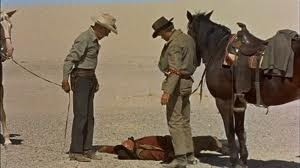
Masters kills Stride’s killer
Boetticher’s Westerns concern “the man who does the right thing without making a fuss,” according to Matt Zoller Seitz’ documentary, Straight Shooting (2008). The character portrayed by Randolph Scott in the cycle is regularly a patient and sensible man, reluctant to use violence but when pushed into a corner, will avenge. He is a hero who is committed to a code of honour. He is also, of course, an amazing marksman, at least in this version of the story. In _7 Men_… we are encouraged to forget this at the film’s conclusion when he is visually balanced with Masters in the shootout amongst the rocks – he is using a rifle as a walking aid because he has an injured left leg. We look – as does Masters – at the injured appendage and not at the working right hand: and his right hand is holding a pistol behind his back. The scene requires that the balance of power between the characters be magically adjusted – the shots of the characters are equal, mid-shot to mid-shot, but the story logic demands that Stride be restored as the protagonist in the narrative. Jim Kitses states:
Whether a dark figure or not, Boetticher’s villain remains a deeply attractive figure for us – we understand him in a way we cannot the hero – and the films stand finally as celebrations of this character who attempts to create action in a way that the static Scott cannot (Kitses, 1969: 105).
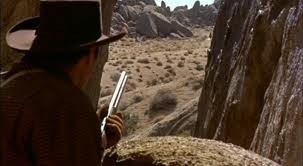
Framing the Killer
The landscape itself comes to represent the inner peace, turmoil and rages of our laconic hero. Boetticher constructs an objective correlative for the drama – Stride is an elemental force that cannot be disputed and the desert, rocks and waterholes embody his drama. What he cannot express in words, the textures and shapes and obstacles express on his behalf. Boetticher understands the power of the image not just for its beauty or terror but for its psychological impact. This has a profundity that goes beyond the traditional aesthetic of the genre and lends it a layer of meaning that is new. The juxtaposition of the open spaces during the day with the enclosed spaces at night, when people talk themselves into trouble, is striking and innovative.
Kennedy recalled being in the dubbing room for _7 Men_…: “There was a scene in a wagon with Lee Marvin, Randolph Scott, and Gail Russell. It was a four-minute scene, and the music composer had written a four-minute, what we call a ‘cue,’ as a background to this scene. When we ran the scene with the music, I realized that there was some funny, grim humor in the scene – and the music, which was dramatic, was making it impossible for the audience to laugh at the lines. I realized that the absence of music in some scenes was equally or more important than the music in the scenes where it really belonged” (Kennedy, 1997: 54-5). The gravitational pull of the scene is rooted in those emotions which are left unspoken in daylight hours; their absurdity is also easier to understand in the still of the night. Kennedy understood the need for quiet and the tension which terrifies without the benefit of sunshine. Here the character’s fears and desires are expressed, the music is in the emotionality.
The villain is not just an obstruction in this screenplay; he is a major character and a well-written antagonist. As essayed by Lee Marvin, he is not just bad to the bone, he is sympathetic and profound, a complex anti-hero whose proclivities simply extend the psychological depths of Stride’s own struggle. His lack of sensitivity to action balances Stride’s need for justice; his penchant for violence is weighted against Stride’s desire for revenge. It might be said that unlike the hero, he controls the direction of the action. This is an important narrative change to the traditional Western structure in which the hero usually initiates change. Masters may appear at first to be a somewhat simplistic villain, forever leading the hero into muddier waters, however this dramatic axis conjoins within the narrative’s moral polarity, the darker predilections and his florid, command of language being infinitely more attractive than the frustrating silence of the wounded hero whose integrity is writ large on his stoic features. He wants a fair fight and saves Stride’s life from a man who would shoot him in the back after Stride mistakenly saved him. Essentially, Masters is a charmer. And, as Kitses reminds us, “No one ever feels the impulse to hiss a Boetticher villain” (Kitses, 1969: 96). It is his entry into the drama that explains the film’s title and hence Stride’s motivation. His physicality is different to Stride’s, he is all motion and life, his presence brings another layer of eventfulness, a contrasting dimension that is full of character and action. It is a cunning narrative stratagem, enlarging upon the major theme in all the Boetticher/Scott films – loss. As Kitses states, “Revenge is meaningless since the wife is dead; yet it is necessary because it is evidence of a way of life that the hero embodies” (Kitses, 1969: 97/8). Stride’s quick drawing is part of his reflexive activity; he has no other choice than to pursue death.
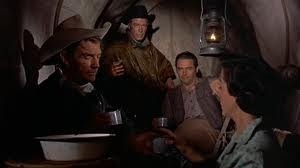
The claustrophobic scene in the wagon
Burt Kennedy had written a screenplay of such spareness as to be skeletal: he would rework the content (and theme) in a couple of more westerns for Scott and Ranown, but in his later career as writer-director he would achieve great success with the comedy Western, a form in which he specialised and which generated a wonderful gallery of crazy characters, wacky misfits and formidable females. Here he worked with Scott, whose very movements and stealthy clean build contrast with Masters’ swagger. He seems to be a feature of the landscape; while the emotional terrain is engraved upon his features.
Bazin stated of the film: “… it is indeed the most intelligent Western I know, while being at the same time the least intellectual, the most subtle and least aestheticizing, the simplest and finest example of the form” (Bazin, 1957). For Bazin, the simplicity was a systematic result of a film’s formal design, something that was always in the ambit of the French critics and their particular style of appreciation and critique, unlike most of their Anglo-Saxon brethren. What Boetticher might be seen to have achieved is to have embraced convention and turned it upon itself so that self-reflexion becomes an inimitable part of the form. Take for example the use of dialogue in the film. As Andrew Horton rightly points out, “It may surprise you how much of most films breaks down to a series of dialogue scenes between two characters” (Horton, 145). For Aristotle, diction (or dialogue) must form part of the dramatic action. He states: Diction should be handled with particular care in those parts in which little is happening, and which are expressive neither of character nor of reasoning; excessively brilliant diction overshadows character and reasoning (Aristotle, 1996: 42). Michael Tierno reiterates, “Dialog is part of the action and gets its power from the plot, whose effect builds in a cumulative as well as linear way. Dialog forms story action and derives life and energy from the action it helps build.” He continues, “in even the most dialog-dependent script … the dialog is intrinsic to the action, to the plot, meaning, causality of the incidents and dramatic unity” (Tierno, 2002: 129-30).
Dialogue is not, then, conversation; it affects the impact of conversation and carries character and action forward. It must differentiate characters from one another, imitate the rhythm of speech and at its best reveal subtext and deep character. Stride’s command of words is simple, stark and straightforward: when they are approached by Chiricahua Apaches and asked if they’re dangerous, he says, “They’re worse than that, they’re hungry,” before giving them a horse to eat (his second of the film.) He says to Masters, “I’d hate to have to kill you.” Masters responds, “I’d hate to have you try.” Kennedy’s dialogue is a joy for actors – it is rhythmic, operating in triadic beats, and perfectly works with the characters’ situations. Masters is prolix, verbose, witty, indulgent: (to Stride) “All that stands between me and $20,000 is you.” And to his sidekick, who is not long for this world: “I was young when I came here, Clete.” He puzzles over Annie’s marriage to a weak-willed creature like John Greer (who is similarly doomed), “It just don’t seem right to me.” “What don’t?” asks Clete. “Why a full woman like that would settle for half a man.” “Maybe you should ask her why.” Masters: “Maybe I will, Clete. Maybe I will.” Later, when Greer makes the ultimate sacrifice, Masters is fair enough to revise his opinion of the man and says to Stride, “Her husband, he talked himself to death in front of the Sheriff’s office in Flora Vista.” Stride responds, “A man can do that.” Masters agrees. His fate, too, is sealed, in a verbal musicality that rings sweetly and with equilibrium.
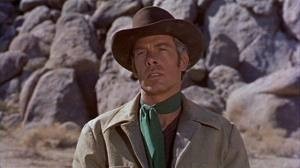
Lee Marvin, the estimable antagonist
7 Men … was not produced by Harry Brown but it retains its significance as the first of an important (if humble) cycle of films in the genre. The genius of its structure, the tautness of the story rhythms and rhymes and the matching of those to the visual spectacle which Boetticher embellishes with just the slightest hint of excess: the rain storm that triggers our awareness of violence at the beginning of the film recurs heralding a re-commencement of the major plot point and in a sense the film’s second beginning, when violence is unleashed once again, thirty-seven minutes into the story (at roughly its halfway point); the enclosure of the covered wagon brings emotional tensions to a head. Boetticher maintains a tight frame for the majority of the film, rarely deviating from a strict compositional pattern in which characters are constantly put under pressure to make moral choices. The empty town which lacks any sense or sight of community when the Greers first enter it, immediately prior to Greer’s murder, is contrasted at the film’s conclusion, filled with people, busy conducting life and business, Annie cancelling her trip further West as Stride disappears up the town’s main street, back into the wilderness from which he first emerged. The juxtapositions are stark and expressionistic, echoing the story’s patterns of universal concerns: the quest for justice, peace and happiness, the need to avenge a dreadful death and the parallel need to avoid pointless killing; the overweening sense of loss. This surely sidesteps the desire to frame the film or Boetticher in the strictest of auteur categories which that critical trend inspired (Schrader, 1970: 23). Sarris placed him in the ranks of ‘Expressive Esoterica,’ telling his readership, “Boetticher is one of the most fascinating unrecognised talents in the American cinema” (Sarris, 1968, 1996: 124). He correctly adduced that the Boetticher/Scott (or Ranown) cycle was a “a new style in the genre,” of which Ride the High Country (1964, Peckinpah) was “an attempted summation.” He states: “Boetticher’s westerns expressed a weary serenity and moral certitude that was contrary to the more neurotic approaches of other directors of this neglected level of the cinema” (Ibid.).
In terms of the dialogue that exists between an audience and the making of a genre film, Schatz refers to Leo Braudy whom he quotes as follows: “ ‘Change in genre occurs when the audience says, ‘That’s too infantile a form of what we believe. Show us something more complicated’.” Schatz continues: “Thus the end of a genre’s classic stage can be viewed as that point at which the genre’s straightforward message has ‘saturated’ the audience… we no longer look through the form (or perhaps ‘into the mirror’) to glimpse an idealized self-image, rather we look at the form itself to examine and appreciate its structure and cultural appeal. If Boetticher’s films exist on the level of the miniature they are no less forceful than the grandest of horse operas. Kitses calls them comedies (as opposed to the tragedies of Anthony Mann’s westerns) and “bitter-sweet reflections on the human condition” (Kitses, 1969: 96).
“A genre’s progression from transparency to opacity – from straightforward storytelling to self-conscious formalism – involves its concerted effort to explain itself, to address and evaluate its very status as a popular form.” Schatz concludes, “The genre film reaffirms what the audience believes both on individual and on communal levels. Audience demand for variation does not indicate a change in belief, but rather that the belief should be re-examined, grow more complicated formally and thematically, and display, moreover, stylistic embellishment” (Schatz, 1981, 38). _7 Men_… contributes to the genre in subtle fashion: it has a strict formal narrative rhyme whose balance and parallel configurations are meted out in logical ways. Stride meets his match in Masters (the names are symptomatic of Kennedy’s understanding of the emotions tilting at the film’s centre). Annie is reminiscent of Stride’s wife. She offers comfort and decency where the whores just offer sex for the night. Stride accomplishes his goal of revenge. The story is divided into seven units of dramatic action to fulfil the promise of the title. Masters loses no opportunity at gunplay, even pretending to fire his pistol in the saloon; when the starving Chiricahuas arrive at the relay station Stride simply hands them a young stallion to eat rather than in engage in bloodshed. Stride mistakenly saves his potential killer’s life; Masters shoots him in the back. “He was fixin’ to cut you down,” explains Masters to Stride. “You know him?” “He sure knew you, Sheriff,” quips Masters. The money is retrieved at the film’s conclusion and returned to its rightful owners. The town whose balance is disturbed by the presence of the villains is restored by a sense (however artificial) of vibrant community life and Stride leaves it confident in his return to his own, original home of Silver Springs. The story commenced when Stride departed Silver Springs; in order for the story to be complete, it demands his return. We began in the middle of his personal drama; it is clearly not yet over.
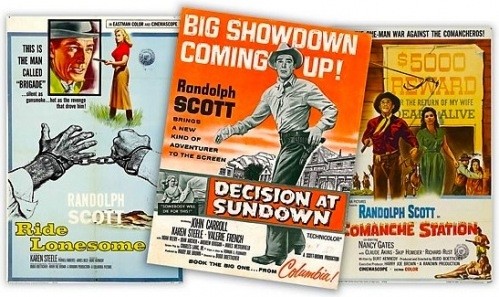
Perhaps the most significant element of any screenwriting signature is the overarching theme, a distinguishing feature of Robert Riskin’s oeuvre and also that of Steven Spielberg (Warren Buckland, 2006, 14-15; 23; Ian Scott. 2006, 125-6, 128). In 1938 Riskin wrote an article entitled, ‘The Theme’s the Thing.’ which, Scott claims, “was [also] a rededication to his own instincts as a writer, to his abilities of forming character and narrative, and a promise of the direction of his future work. The article contended that he was foremost a writer and that themes were the heart and soul of his writing” (Scott, 126). Egri formulated the classic approach to dramatic writing in which he states premise – or theme – as the central component of the successfully written play: “Every good play must have a well-formulated premise. There may be more than one way to phrase the premise, but, however it is phrased, the thought must be the same” (Egri, 1945: 6). He also states: “In a well-constructed play or story, it is impossible to denote just where premise ends and story or character begins” (29). “Neither the premise nor any other part of a play has a separate life of its own. All must blend into an harmonious whole” (31).
Ultimately the film derives its force from the deployment of elemental narrative structure, never losing focus of Stride’s motive and the film’s fulcrum – revenge. The textures of authorship recognisable both from Kennedy’s writing and Boetticher’s emphatic visual signature reinforce its power as a minor masterpiece, engaging with primal emotions and iconic story lines. The various critical methodologies which have evolved around film are principally to do with a film’s provenance. And, as Matthew Sweet reminds us, “the history of film criticism has created its own orthodoxies” (Sweet, 2008: 4). Like a piece of art, a film’s value is directly attributable to the signature in the corner of the frame. However, if it is possible to accept in principle that film is a collaborative venture where does that leave the screenwriter in terms of the attributing of a single cinematic signature?
The protagonist and his structured journey in 7 Men_… is of course the template to which the remaining six films would adhere. The Western hero as evinced by Kennedy is given one of literature’s finest motivations: revenge. And, Boetticher’s films are, above everything else, personal. As Jim Kitses states, “Boetticher appears a diminutive and isolated figure working in the shadows, trying to create his art wholly out of himself” (Kitses, 89). And he was Randolph Scott’s first choice as director. The case for Burt Kennedy as cinematic auteur lies in those tropes which mark his particular style of authorship – a consistency of dramatic elements as well as a special talent for writing the kind of rhyming, expressive dialogue that actors love to speak. In _7 Men … the greatest dialogue is given to Masters and Lee Marvin’s richly cadenced voice makes a meal of it. A survey of Kennedy’s work demonstrates the kind of themes and qualities that compare with those characteristics normally attributed to auteur directors and here qualify as a means by which to identify the screenwriter’s signature throughout a large body of work, collaborative and otherwise. Andrew Sarris’ interpretation of his body of work as director is under the rubric, ‘Lightly Likable.’ He continues:
Kennedy’s directorial style seems more discursive and less dramatic than Boetticher’s. There is also more realistic and psychological clutter in Kennedy’s mise-en-scene than in Boetticher’s (Sarris, 1968: 181).
Therefore the rigour which Sarris so admires in Boetticher’s directorial control is not something which we detect in Kennedy’s films as directed from his own writing. Kennedy’s screenwriting style is detailed, humorous and lightly ironic. His characterisation of Stride is deeply touching because of his own tragic self-awareness and absurd righteousness. Kennedy’s own recollection of writing 7 Men … is typically self-effacing as he recalled that when writing it for John Wayne’s company, Batjac, he got $1,500 for a story he’d had the title for years earlier. “I took the title, they gave me an office and a legal pad and pencils and I sat down in this little office Wayne Fellows and wrote Seven Men From Now” (Kennedy, 1997: 6). Duke liked it and sent it to Warner Bros., where Jack Warner loved it. However Wayne was in the middle of making The Searchers (1956, Ford.) And so after it was turned down by Robert Preston, Randolph Scott received a copy and he hired Budd Boetticher to direct. Kennedy wrote, “Seven Men From Now was my first picture and was very well received. I went on to get Duke to buy an Elmore Leonard story called ‘The Captives’ which paid $5,000 for and for which I did the screenplay” (Kennedy: 7).
Jim Kitses says of Boetticher’s oeuvre, “On the one hand there is the deepest commitment to a highly romantic individualism: life is seen as a solitary quest for meaning, an odyssey, action as a definition and expression of the self which is its own reward, compromise of personal integrity as indefensible. On the other hand there is Boetticher’s chosen profession, the corporate and glossy public world of an industrial art, the Hollywood cinema, within which he was buried… for fifteen years” (Kitses, 91). On Kennedy’s move into direction Kitses commented in 1969, he “has begun to reveal a sensibility far removed from the irony, discipline and stark confrontations of the Ranown cycle. While often quoting from the earlier scripts (sometimes in chunks), his work has tended to a broad comedy (often relaxing into vulgarity) which suggests the common ground that sustained this fertile collaboration” (92). If, as Sarris claims, “Boetticher’s films strip away the outside world to concentrate on the deadly confrontations of male antagonists,” then the final duel between Stride and Masters is exemplary in its balance when the power must be reconfigured once again and Stride regains his primacy. He shoots with a sleight of hand of almost unbelievable flair – it seems desperately unfair that this wonderfully flamboyant and fair-minded villain is killed with such deliberate effect in such a divinely inspired movement: Masters is the true hero of the film. Paul Schrader recognises that “in the Ranown cycle the Boetticher-Kennedy characters save or damn themselves through moral decisions. Scott continually confronts his enemy with the moral question” (Schrader: 28). He continues: “Scott’s deep irony is unique in Boetticher’s films and is probably a by-product of the working relationship with screenwriter Burt Kennedy. One might hypothesize the interaction of Boetticher-Kennedy like this: Kennedy sought to ‘play with’ the Scott character, leading him into confusing, embarrassing, and demeaning situations … they are the type of indignities which Kennedy likes to inflict upon his heroes in his later westerns and they do not occur in Boetticher’s bullfighting films which were not scripted by Kennedy… Out of this Boetticher-Kennedy tension evolves a modern, ironic archetype” (Schrader: 29). The coming together of these sensibilities – the one ironic, paradoxical and funny; the other romantic, ritualistic and individualistic – makes for a heady artistic combination.
The dramatic and emotional logic of the narrative drive demands that Stride once again retreat into the landscape which begot him. He rides off in long shot, exiting the artificial town: in his wake, the imprint of his revenge on all who encountered him and the image of the woman who would delay her life in California to perhaps follow him back to Silver Springs. The newly invigorated Flora Vista is clearly created as a mirror of what Silver Springs could be, civilised. This would be the story template for the following Scott/Boetticher productions. It was an X-ray which allowed for the spaces between people to speak of wistfulness, longing, contemplation and possibilities. If the film overall does not re-define the parameters of the Western in the wake of those 1950 releases which re-calibrated them, it refines those elements which make it great. The later Kennedy scripts for the cycle – The Tall T (1957), his Elmore Leonard adaptation; Ride Lonesome (1959); and Comanche Station (1960) – would be even tauter variations on the same skeletal form. (He would also do some uncredited work on Buchanan Rides Alone (1960).) There is no transformation here, no redemption. Men want what they want and they go for it and they get killed for it. As Sarris says, “No audience is required for the final showdown. It is man to man in an empty arena on a wide screen before a very quiet, elemental camera. Elemental but not elementary” (Sarris: 125). While Kennedy would become identified as an author of the comedy Western, here he devised a singular mode of expression which dovetailed neatly with Boetticher’s generic and aesthetic impetus and the structure which led to 7 Men From Now being lauded for its exuberant achievements on the frontiers of genre – then and now.
BIBLIOGRAPHY
BooksAristotle (1996). ON THE ART OF POETRY. Oxford: Oxford University Press.
Bazin, André (1955). “The Western or the American Film par excellence,” in Hugh Gray (ed./transl.) WHAT IS CINEMA? Volume 2. Berkeley: University of California Press, 149-157.
_______ (1998). “Evolution of the Western,” in Jim Kitses and Greg Rickman (eds.) THE WESTERN READER. New York: Limelight Editions, 49-56.
Bordwell, David (1985). NARRATION IN THE FICTION FILM. Madison Dell Publishing Co.: University of Wisconsin Press.
Buckland, Warren (2006). DIRECTED BY STEVEN SPIELBERG: Poetics of the Contemporary Blockbuster. London and New York: Continuum Books
Cohan, Steve (2000). “Case Study: Interpreting Singin’ in the Rain,” in Gledhill and Williams, op.cit.
Egri, Lajos (1946, 1960). THE ART OF DRAMATIC WRITING: Its Basis in the Creative Interpretation of Human Motives. New York, Touchstone Books.
Gledhill, Christine and Linda Williams (eds.) (2000). REINVENTING FILM STUDIES. London: Bloomsbury Academic.
Kaminsky, Stuart M. (1977). AMERICAN FILM GENRES: Approaches to a Critical Theory of Popular Film. New York: Nelson-Hall.
Kennedy, Burt (1997). HOLLYWOOD TRAIL BOSS: Behind the Scenes of the Wild, Wild West. New York: Boulevard Books.
Kitses, Jim (1969). HORIZONS WEST: Anthony Mann, Budd Boetticher, Sam Peckinpah: studies of Authorship within the Western. London: Thames and Hudson/BFI.
Kitses, Jim and Gregg Rickman (eds.) (1998). THE WESTERN READER. New York: Limelight Editions.
Langford, Barry (2005). FILM GENRE: Hollywood and Beyond. Edinburgh: Edinburgh University Press.
Lopate, Philip (ed.) (1995). AMERICAN MOVIE CRITICS: An Anthology From The Silents Until Now. New York: Library of America.
Monaco, James (1979). AMERICAN FILM NOW: The People, The Power, The Money, The Movies. New York: Plume Books, New American Library.
Russell, Lee (1965) ‘Budd Boetticher,’ in Kitses and Rickman, op.cit.: 195-200.
Ricoeur, Paul (1990). TIME AND NARRATIVE Volume 1. Chicago: University of Chicago Press.
________ and David Pellauer (1995). FIGURING THE SACRED: Religion, Narrative and the Imagination. Minneapolis: Augsburg Fortress.
Sarris, Andrew (1968). THE AMERICAN CINEMA: Directors and Directions, 1929-1968. Chicago: University of Chicago Press. Reprinted 1996 by Da Capo Press.
Scott, Ian (2006). IN CAPRA’S SHADOW: The Life & Career of Robert Riskin, Screenwriter. Kentucky: University of Kentucky Press.
Tierno, Michael (2002). ARISTOTLE’S POETICS FOR SCREENWRITERS. New York: Hyperion.
Warshow, Robert (2001). ‘Movie Chronicle: The Westerner’ in IMMEDIATE EXPERIENCE: Movies, Comics, Theatre and Other Aspects of Popular Culture.
Journal & newspaper articlesAxmaker, Sean (2005). ‘“Budd Boetticher: Last of the Old Two-Fisted Hollywood Directors.” 6 December 2005, Greencine. Accessed 12 October 2012.
________ (2006). ‘Ride Lonesome: The Career of Budd Boetticher,’ Senses of Cinema. Accessed 12 October 2012.
Bazin, Andre (1957). ‘An Exemplary Western,’ Cahiers du cinéma, Augsust- September.
Croce, Fernando F. (2005) ‘Seven Men from Now,’ Slant Magazine, 24 December 2005. Accessed 12 June 2012.
Handzo, Stefan (1976). “Going Through the Devil’s Doorway: The Early Westerns of Anthony Mann”: in Bright Lights Film. Accessed 04 July 2012.
Johnson, Gary. ‘Ride Lonesome,’ Images Journal, Issue 10, Accessed 14 June 2012.
Kennedy, Burt (1969). ‘Our Way West,’ Films and Filming, London, October 1969.
Morgan, Daniel (2006). “Rethinking Bazin: Ontology and Realist Aesthetics,” Critical Inquiry, Spring 1006: 443-481. Rethinking Bazin. Accessed 05 October 2012.
Schickel, Richard. “Blue Velvet,” review reprinted in Philip Lopate, (ed.), 559. Originally published in FLESH AND BLOOD: The National Society of Film Critics on Sex, violence, and Censorship. Ed. Peter Keogh. San Francisco: Mercury House, 1995.
Schrader, Paul (1970). ‘Budd Boetticher: A Case Study in Criticism,’ Cinema, Vol. 6 No. 2, Fall 1970: 23-29.
Stempel, Tom. Slant Magazine. Accessed 05 July 2012.
Sweet, Matthew (2008). ‘Our Greatest Lost Film Critic,’ Film & Music, The Guardian, 09 May 2008.
Zoller Seitz, Matt (2008). ‘Straight Shooting,’ Moving Image. Accessed 13 October 2012.
Online resourcesCopyright: All images copyright Ranown Pictures and Batjac Productions.

